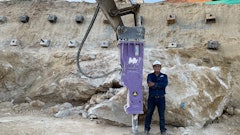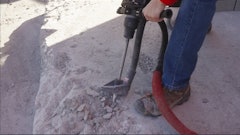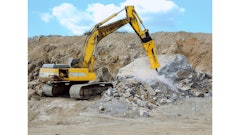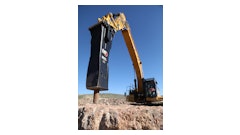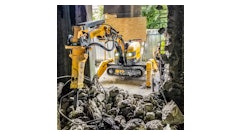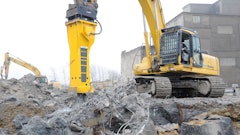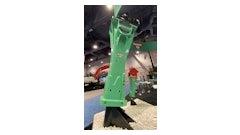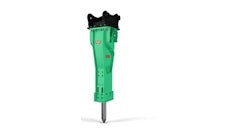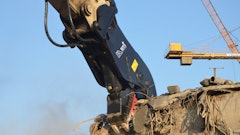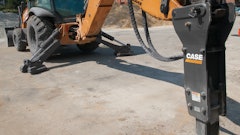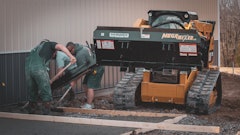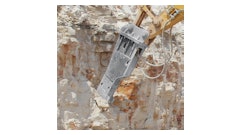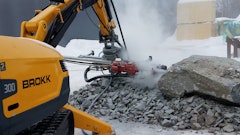
Hydraulic breaker attachments are designed to withstand the harshest of operating conditions. Yet, the repeated impacts and vibration they're subjected to throughout their use will inevitably result in wear over time, necessitating a rebuild or, in severe cases, outright replacement.
How quickly a breaker reaches this point lies in part in the hands of the equipment operator. Improper operation can significantly shorten breaker component life and drive up repair/replacement costs. As such, it's important to recognize and correct poor operating practices before they result in premature failures.
Compatibility is key
Before an operator even gets behind the controls, he or she needs to make sure the carrier and breaker attachment are a good fit.
"It's a mistake to run a big hammer on a smaller excavator, and vice versa," states Rob Sherwin, president/CEO, Arrowhead Rockdrill Co. Inc. "Serious damage may occur to either, or both, the hammer and machine."
Match the size/weight of the breaker to the carrier lift capabilities to ensure operating stability. Then make sure the hydraulic capabilities are compatible.
The hydraulic flow and pressure relief setting on the carrier are the two main concerns, according to Gary Thompson, product manager - mounted breakers, Stanley Hydraulic Tools. "You can either overflow the breaker and cause damage," he states, "and/or if you have the relief setting too low, you won't get enough operating pressure before it goes over relief, causing heat in the system."
It's also important to make sure the breaker and carrier are properly set up for the application. For example, some jobs require the breaker to be operated with part or all of the attachment submerged under water. In such cases, the breaker and carrier must be properly set up for underwater use.
"One of the ways that a contractor can [misuse] a breaker is to run it under water without a proper underwater kit on the excavator," says Greg Smith, marketing communications manager, Allied Construction Products, LLC. "Without an underwater kit and an air compressor, water will be 'sucked' into the breaker and contaminate the carrier's hydraulic system. [This] will cause damage, downtime and expensive repair costs to the breaker, as well as the excavator."
Know where to start
Operators should be trained in how to properly position a breaker to optimize productivity and minimize stress on the attachment and carrier.
"Some customers that are new to breakers will take a big chunk of concrete and start in the middle," says Kelly Steck, director of marketing, Stanley Hydraulic Tools. "They will get frustrated because the bit is getting hot (melting) and they're not seeing any productivity."
Sherwin has seen similar scenarios where an operator attempts to break material such as a boulder with the working tool positioned in the center. "In this instance, the hammer is not penetrating and is 'drilling' rather than breaking the rock," he points out. This can generate excessive amounts of both dust and heat. "There is heat buildup at the point of the tool and, after a sustained period, the working tool starts to burr up at the edges. This is commonly known as 'mushrooming' of the tool. At this point, the integrity of the working tool is compromised and more severe failure could result.
"Combine this with the increased vibration and recoil that transmits back up the excavator's boom, and excessive overworking of the excavator's hydraulic system," he continues, "and there is a potential - with continued misuse - to cause damage to the excavator."
Operators should be trained to start breaking at a corner or edge of the material and work their way inward, and to frequently reposition the tool. "One rule of thumb of experienced operators is to keep the tool moving enough during breaking," says Smith. "Operating in one spot will lead to an increase in hydraulic temperature."
Encourage the use of "scoring" to penetrate material - in other words, break in one spot, move the tool over, break in another spot and so on. "Sometimes, the rock or concrete will not break the first time," says Sherwin, "so keep repositioning every 15 to 30 seconds until it breaks."
Operators should also be instructed to keep blank firing to a minimum. Blank firing occurs when the breaker is operated with the tool suspended in the air, causing the piston to fire inside the housing. This can be hard on tie rods.
"Blank or dry firing is somewhat inevitable," Sherwin states. "But [it] should be kept to an absolute minimum, as this can potentially cause major internal damage, and at the very least tie rod breakage."
Don't pry
Raking or prying with the tool bit to maneuver material is another common operating mistake. "Operators should avoid excessive prying as it can cause tool point breakage and damage to the hammer," Smith cautions.
"Excessive side loading, or prying, at the same time as firing the hammer will result in tool breakage," Sherwin agrees. "Using the tool to move the broken material around too aggressively will cause damage on the surface of the tool, resulting - in extreme circumstances - in failure of the tool at the point of damage."
The cost of replacing a broken tool can range anywhere from around $400 for a backhoe-loader up to $5,000+ for a large excavator. But the cost to replace other components is significantly higher. "There, you start running into more dollars," says Steck. "You lessen the life you get out of that breaker. You're faced with having to rebuild the breaker sooner than anticipated, and the bill to rebuild gets steeper.
"It's like any piece of equipment," he adds. "Treat it well and you're going to have a better payback."
Minimizing damage by design
No matter how diligent you are in training, or policing, your operators, breaker misuse will periodically occur.
"You can sit there and say don't pry or don't blank fire, but the real world is guys are going to go out there and do it," says Steck. "So it's up to the manufacturers to lessen the damage when that happens."
To start with, breaker manufacturers are simplifying the daily service operators are required to perform. For example, most breaker attachments require greasing of the lower tool holder bushings and tool every two to three hours to prevent metal on metal contact that can cause premature tool bushing wear. Auto lube systems are available to help eliminate manual greasing requirements.
"Auto lube systems - either onboard or excavator mounted - are a worthwhile addition to any hammer package," says Sherwin. "When larger hammers and excavators are being used, the working tool and bushing life are improved significantly by installing auto lubrication."
Allied's latest breaker design takes this a step further by incorporating lubrication into the attachment. "The Allied in-Series Sandvik (Rammer) hammers are sealed to keep lubrication in the hammer and contamination out," says Smith. "This means the operator never has to lubricate (grease) the hammer. This design innovation makes the hammer 'daily maintenance-free'."
Other features in today's breaker designs are intended to minimize the wear and tear encountered during operation. For example, vibration dampening helps to protect both the breaker and the carrier.
"The development of highly effective vibration reduction systems in hammers today does limit the amount of stress that is put on the boom and the excavator in general," says Sherwin.
Arrowhead Rockdrill 'S' series breakers use oversized polyurethane isolators to support the power cell at the top and bottom, eliminating metal-to-metal contact. The compression system also improves vibration dampening, "virtually eliminating any transmission of vibration or recoil up through the boom," Sherwin explains. An added benefit is tie-rod protection. "TRP (tie-rod protection) technology gives increased protection of the power cell against the effects of side loading and excessive blank firing."
Stanley Hydraulic Tools offers features that minimize the negative effects of both blank firing and prying. "We allow the tool bit to drop out of the way so that it's not always in the line of fire if the operator continues to blank fire," Thompson points out. "The tie-rod design has been improved and the lower bodies have been changed to make parts stronger so the lower body can withstand some of the blank firing."
In the case of prying, the company's smaller series of breakers feature brackets mounted to the lower body only. The working end of the attachment (piston and cylinder) "floats" on top of the lower body. "If you pry, you're not twisting the piston so that it's running at incorrect alignment," Steck explains. "This reduces damage to the internal components of the breaker if you pry."
"In our other designs," Thompson adds, "we have rubber-mounted housings where the power cell is actually floating in rubber - top, bottom and sides - to lessen the impact to the hammer itself and also to the carrier."
No substitute for training
Even with such design advancements, wear and damage will gradually occur over a breaker's life. As such, basic inspection and service of the attachment should be part of an operator's training regimen.
"Once the operator is trained [in breaker operation], the role he plays is to watch the breaker to make sure it's lubricated and maintained; visually inspect the breaker to make sure... there isn't any damage that could turn into something bigger; and to watch for wear items, tool bits, bushings and replace them on a timely basis," Thompson states.
"Operators should be encouraged to perform a basic inspection on the hammer, check the oil levels in the hydraulic system and report any defects or damage immediately," says Sherwin. "Preventive visual inspection of the hoses, mounting bracket, box and tool/lower bushing only takes two or three minutes at the start of the work day, but can save downtime and expense if acted upon in a timely fashion."
Understanding the basic working principles of a breaker can also prove beneficial. "A well-informed operator can identify if a hammer is performing correctly, or if there is a potential issue and take action to remedy the problem, if possible," says Sherwin.
"Operator knowledge and experience are two key factors to think of even before considering procedures for operation," Smith adds. As such, he suggests dedicating operators to a specific machine and breaker. "In this way, that dedicated operator 'gets to know' the hammer and how to get the most productivity out of it."
Taking steps to enhance operator expertise is just one more way to keep breaker life-cycle costs under control. "Operator education and training," Sherwin asserts, "are invaluable in combating costly repairs and needless damage to both the excavator and hammer."









